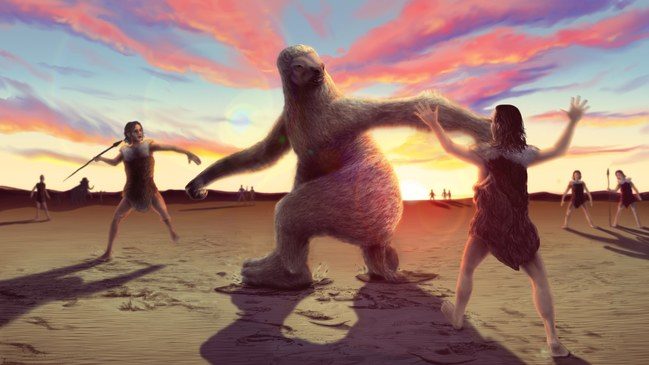
A paper in this week's issue of Science Advances offers tantalizing evidence of that grim process in action. Archeologists working at White Sands National Monument, in New Mexico, found a series of fossilized footprints made by giant ground sloths, lumbering behemoths that once roamed North and South America. The tracks date to between ten thousand and fifteen thousand years ago, when the region was much wetter than it is today. The giant sloth was herbivorous but nonetheless a fearsome creature-eight feet tall when standing on its hind legs, with long arms, and long claws extending from its padded feet.
The researchers noticed something curious inside many of the sloth prints - human footprints, made not long after the sloth's, the stride intentionally adjusted, as if the person were stalking the animal. The tracks of several sloths, and of several people, were found. The dating is imprecise, so the researchers can't say with certainty whether the prints represent several events that took place during a span of time or just a single pursuit; perhaps the sloths were travelling as a group and were collectively harassed. In either case, a chase was under way. The sloth prints show sharp changes in direction, especially in areas where human footprints are numerous; they zigged, we zigged. In places, the sloth appears to have reared up, perhaps to fend off an attacker.
The researchers dismissed the possibility that the human track-maker was following the sloths simply to find an easier path through soft terrain. "The step length results in a long and uncomfortable human stride," they note in the paper. Likewise, the interaction probably wasn't "playful," given the animal's disposition. "A big animal like that would have come with huge amounts of risk," Matthew Bennett, a professor of environmental and geographical sciences at Bournemouth University, in the U.K., and one of the paper's authors, says in an accompanying video. "Going head to head with a sloth, the chances are that you might come off badly." Many archeological sites offer only a static portrait of ancient life, but the team's findings shed light on how we actually interacted with a now-extinct species. "We can begin to understand how they did it, how they actually stalked and attacked these large animals," Bennett says. "And that gives us a better understanding of whether we, as humans, are guilty or not in the role of extinction."
It's a role that our species hasn't outgrown. A separate paper in the same issue of Science Advances offers the most accurate count yet of the world's great apes; the data are drawn from fieldwork done in fifty-nine countries by a global team of biologists and anthropologists. The results are initially reassuring: the researchers estimate that nearly three hundred and sixty-two thousand gorillas and a hundred and twenty-nine thousand chimps still live in Western Equatorial Africa, higher figures than in previous estimates. But eighty per cent of the populations of both species are in unprotected areas, outside the boundaries of parks or preserves, and all are under constant threat from poaching, disease, and the loss of habitat. The authors estimate that gorillas, already a critically endangered species, are declining in number by 2.7 per cent each year. Archeology continues to unfold around us, as one species after another slips forever into the fossil record. Ours is following a primitive track, heading we all know where.
- Alan Burdick, a staff writer, joined The New Yorker in 2012. He is the author, most recently, of "Why Time Flies: A Mostly Scientific Investigation."Read more »



Comment: The results aren't conclusive, because as the paper states timing is off and clearly much is open to interpretation - but if the meat was tasty, why wouldn't our ancestors have barbecued sloth?
For more on the happenings of that time, see: Of Flash Frozen Mammoths and Cosmic Catastrophes
Also See: